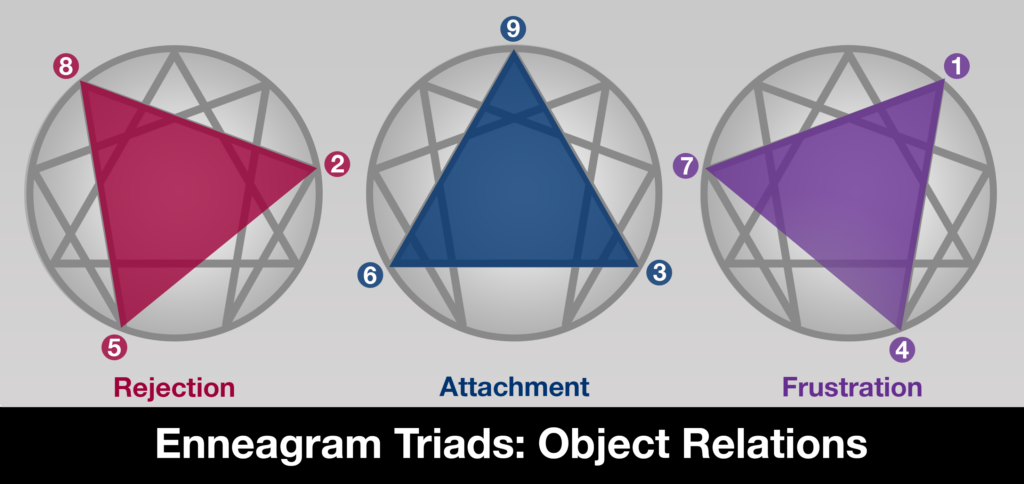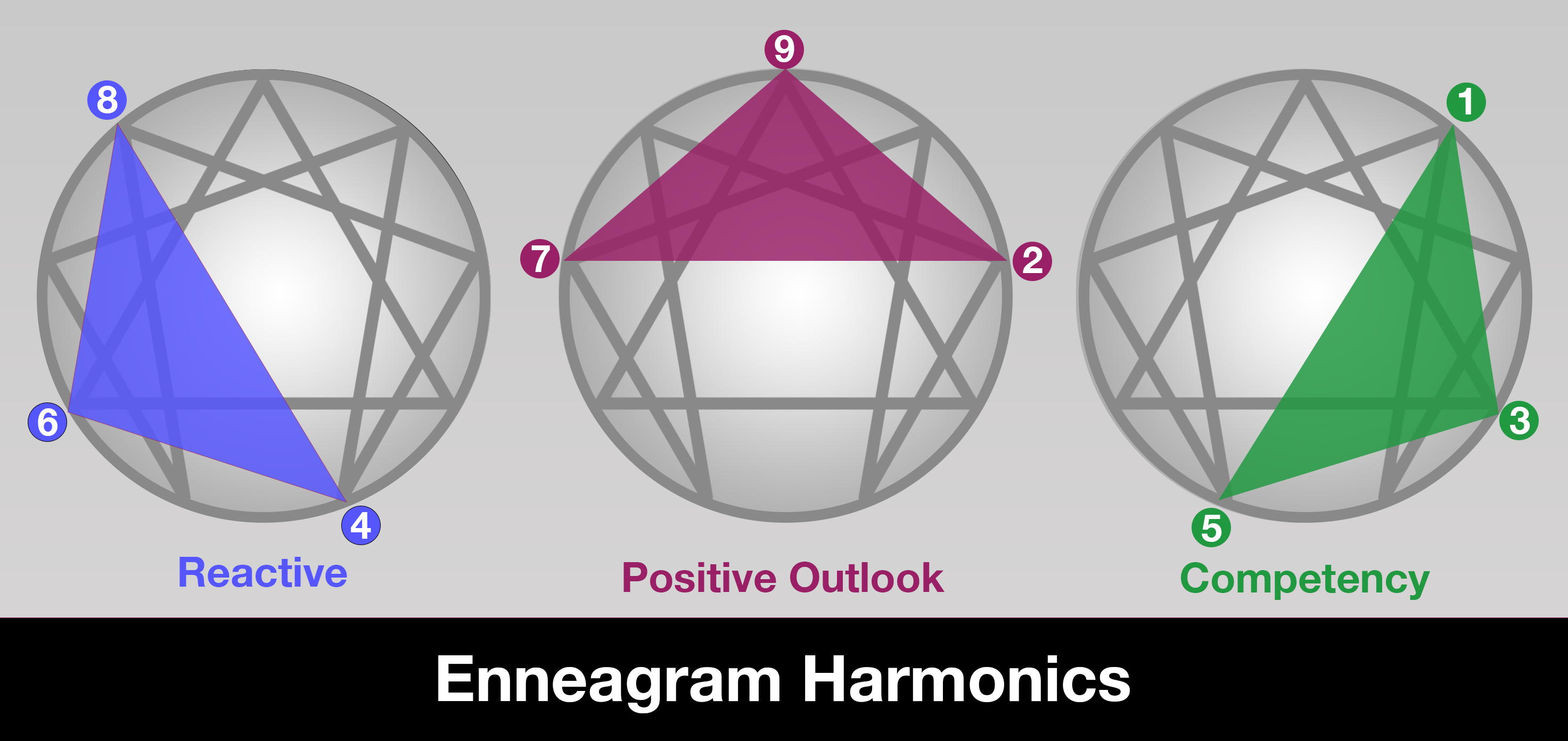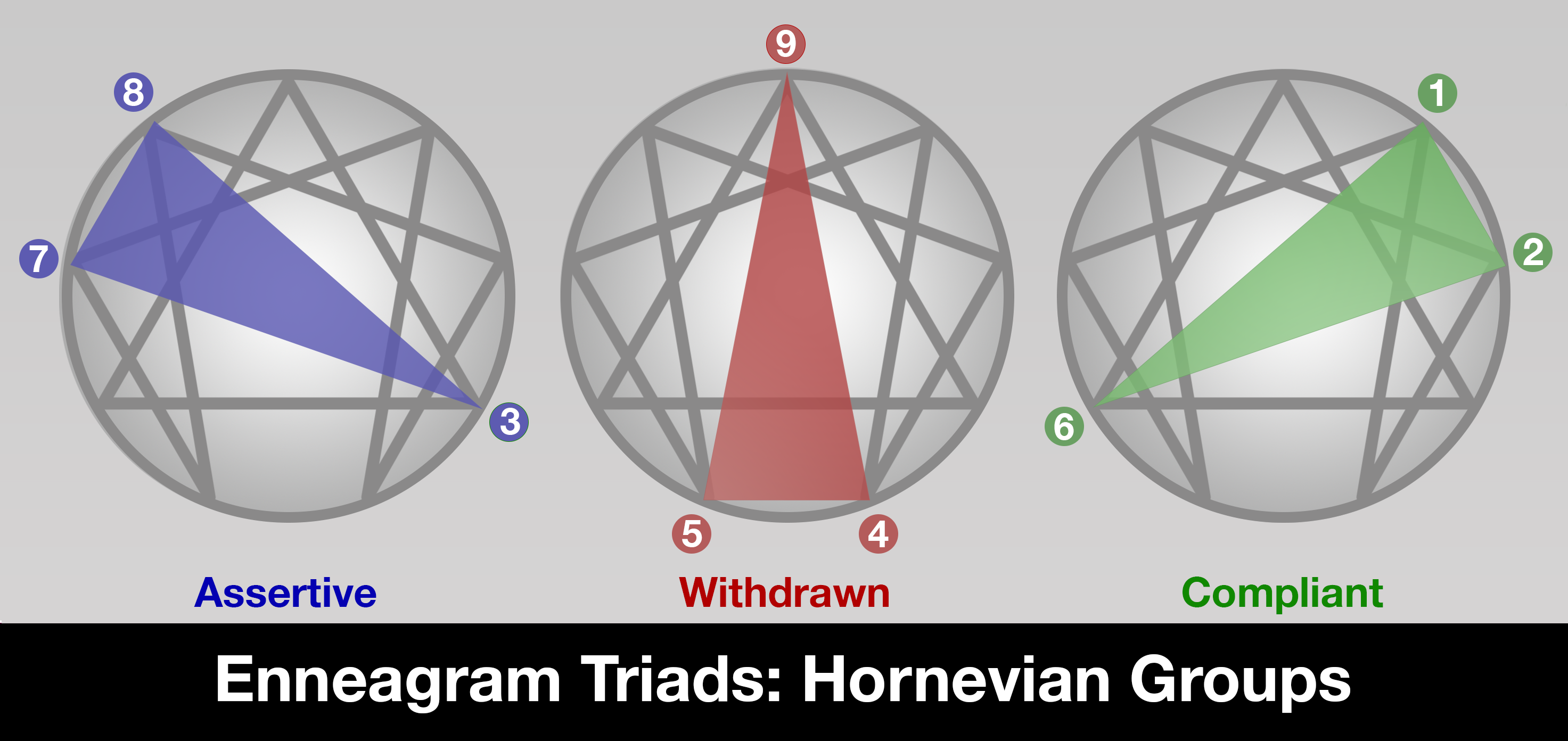The Enneagram contains many kinds of triads, which is a group of three. The main triads of the Enneagram are based on the three centers of intelligence: mind, heart, and gut (or body), which give rise to the thinking, feeling, and instinctive triads.
In addition to those triads, there are three more well-known groups of triads: Object Relations, Harmonics, and Hornevian Groups.
Centers of Intelligence: Mind, Heart, Body

According to Enneagram theory, Humans have three main centers of intelligence or consciousness, and each center is the source of certain functions or capacities. This is not the same as the chakra system, though they are somewhat correlated. Those three centers are:
- Mind Center: The source of thinking capacities.
- Heart Center: The basis of emotional or feeling capacities.
- Gut Center (or Body Center): The basis of instinctive capacities.
There are three basic emotional states that are associated with each of the three centers:
- Mind: Fear, Worry or Anxiety
- Heart: Shame
- Body/Gut: Anger
Each center is associated with particular psychological issues:
- Mind: Security
- Heart: Image
- Body/Gut: Autonomy
All 9 Enneagram types are divided into three triads based on these centers, and each type reflects the emotions and issues of its respective center in a unique way. Those triads are:
- Mind: Types 5, 6, 7
- Heart: Types 2, 3, 4
- Body/Gut: Types 8, 9, 1
Furthermore, each type has either over-developed the capacities of their respective center, underdeveloped those capacities, or are out of touch with those capacities. This results is a pattern of over-expressing, under-expressing, or repressing each center.
- Types 2, 5, and 8 over-express their center.
- Types 1, 4, and 7 under-express their center.
- Types 3, 6, 9 are repressed in, or out-of-touch with, their center.
The Mind Center: Thinking, Fear, & Security
The mind center is responsible for thinking, and particularly for planning for the future. This results in a fear about the future and not having everything one needs to be safe and secure. The three types of the mind triad are 5, 6, and 7, and each type experiences the mind center differently and deals with its issues in a particular way:
- Type 5: Over-expresses thinking.
- Type 6: Out of touch with thinking.
- Type 7: Under-expresses thinking.
The Heart Center: Feeling, Shame, & Image
The heart center is responsible for feeling, and particularly for planning for the future. This results in a fear about the future and not having everything one needs to be safe and secure. The three types of the heart triad are 2, 3, and 4, and each type experiences the mind center differently and deals with its issues in a particular way:
- Type 2: Over-expresses feeling.
- Type 3: Out-of-touch with feeling.
- Type 4: Under-expresses feeling.
The Gut Center: Instinct, Anger, & Autonomy
The gut or body center is responsible for instinct, and particularly for planning for the future. This results in a preoccupation with boundaries, and anger from boundaries being transgressed or violated. The three types of the gut triad are 8, 9, and 1, and each type experiences the gut center differently and deals with its issues in a particular way:
- Type 8 over-express instinctive drives.
- Type 9 is out-of-touch with instinctive drives.
- Type 1 under-expresses instinctive drives. Instead, they sublimate their instinctive impulses by channeling them into
Here is a summary of the three centers:
| Center | Enneagram Types | Function | Emotions | Associated Issues |
|---|---|---|---|---|
| Mind | 5, 6, 7 | Thinking | Fear, Worry, Anxiety | Security |
| Heart | 2, 3, 4 | Feeling | Shame | Image |
| Gut / Body | 8, 9, 1 | Instinctive | Anger | Autonomy |
The Object Relations Triads

Object Relations Theory (ORT) is a psychological theory about how human personalities or egos develop in relationship with early caregivers (usually parents). The key founders of Object Relations Theory include Melanie Klein, Donald Winnicott, Ronald Fairbairn, and Harry Guntrip.
The word “object” in object relations represents the recognition that a very young child doesn’t have a true relationship with the parents themselves, but with an internal, mental representation of the parents. This internal image of the parent(s) is called the object, or sometimes the selfobject, to represent the lack of differentiation between the self and the object (or parents) in a young developing ego.
The Object Relations triads are based on three particular object relations, which Don Riso called “Dominant Affects”:
- Attachment (Type 3, 6, 9): The “positive” object relation that one feels in relationship with another person when one’s needs are being met. This was called the “central” object relation by object relations theorists.
- Rejection (Types 2, 5, 8): The object relation that results from one’s emotional needs being disregarded or rejected.
- Frustration (Types 1, 4, 7): The object relation that results from one’s emotional needs being inconsistently or unreliably met.
In the Summer of 2008, Beatrice Chestnut, PhD published a report in The Enneagram Journal entitled “Understanding the Development of Personality Type: Integrating Object Relations Theory and the Enneagram System“. Chestnut attempted to align the models of several object relations theorists (Margaret Mahler, Melanie Klein, Thomas Ogden, and Heinz Kohut) with the Enneagram, in order to describe more precisely “how early relationships form the basis of personality development” (p. 22-23). Dave Taylor published a response in 2009,
The Harmonics Triads
Enneagram Harmonics describe how each type copes with conflict and difficulties, and how they defend against disappointment (when they don’t get what they want). The three Harmonics groups or triads are Positive Outlook, Competency, and Reactive or Emotional Realness.

Competency Group (Types 1, 3, and 5)
The Competency Group is composed of types 3, 1, and 5. These people have learned to deal with difficulty by putting aside their personal feelings and striving to be objective, effective, and competent. They suppress their needs and emotions, and they try to solve problems logically and expect others to do the same.
| Type | Emphasizes | Manages Feelings | Relates To System |
|---|---|---|---|
| ONE | Being correct, organized, and sensible. They focus on standards, improving themselves, and knowing the rules. | By repression and denial. Feelings are channeled into activity, getting things done perfectly. Feelings also held as physical rigidity in the body. | Ones want to work with the system. They try to be a “good boy or girl,” and are irritated with people who disregard the rules. |
| THREE | Being efficient, capable, and outstanding. They focus on goals, being pragmatic, and knowing how to present self. | By repression and keeping attention on tasks, staying active. Achievement offsets painful feel- ings. Threes look to others for feeling cues. | Threes want to work with the system but also like being outside of it—bending rules and finding “short-cuts.” |
| FIVE | Being the expert and having deep information. They focus on the pro- cess, objective facts, and on main- taining clarity and detachment. | By splitting off and abstracting feelings, Fives stay preoccupied and cerebral, as if their feelings were happening to someone else. | Fives reject the system and want to work on their own, outside of it. They have little patience with rules or procedures |
Positive Outlook Group (Types 2, 7, and 9)
The Positive Outlook Group is composed of types 9, 2, and 7. All three respond to conflict and difficulty by adopting a positive attitude, reframing disappointment in a positive way. They emphasize the uplifting aspects of life and look at the bright side of things. These types enjoy helping other people feel good because they want to stay feeling good themselves.
These types struggle with facing the dark side of life; they avoid looking at anything painful in themselves or others. Each has trouble balancing their own needs with the needs of others. Twos mainly focus on the needs of others, Sevens mainly focus on their own needs, and Nines try to focus on both, although often with the result that they have trouble adequately fulfilling either.
| Type | Emphasizes | Avoids Seeing | Problems With Needs |
|---|---|---|---|
| TWO | Positive self-image. “I am a caring, loving person.” They focus on their good intentions. | Their own neediness, disappointment, and anger. | Twos overemphasize the needs of others, and neglect their own needs. |
| SEVEN | Positive experiences, enjoyment, activity, excitement and fun. | Their pain and emptiness: their role in creating suffering for self and others. | Sevens overemphasize their own needs, and easily feel burdened by the needs of others. |
| NINE | The positive qualities of others and of their environment. They idealize their world. | Problems with their loved ones or their environment as well as lack of their own development. | Nines can feel overwhelmed by their own needs and needs of others. They do not want to deal with either. |
Reactive / Emotional Realness Group (Types 4, 6, and 8)
The Reactive / Emotional Realness Group is composed of types 6, 4, and 8. These have strong emotional reactions to conflicts and problems and have difficulty knowing how much to trust others. “I need you to know how I feel about this.” When problems arise, these types look for an emotional response from others that mirrors their concern. In conflicts, these types want the other person to match their emotional state. “This is really bothering me! It should bother you, too!” The types in this group have strong likes and dislikes. If there is a problem, others are going to hear about it. In conflicts, they need to deal with their feelings first, and usually once they are able to do so, things can blow over fairly quickly and permanently. If they’re not able to vent their feelings, these types can become increasingly resentful and vindictive.
| Type | Seeks | Fears | Deals With Others By |
|---|---|---|---|
| FOUR | A rescuer, some-one to understand them and support their life and dreams; Fours want to be seen. | Abandonment—that no one will care for them; that they will not have enough support to find and become themselves. | Keeping others interested by limiting access, playing “hard to get,” and holding onto supporters. |
| SIX | Both independence and support. Sixes want someone to rely on, but also needs to be “the strong one.” | Being abandoned and without support, but also fears becoming too dependent on others. | Being committed and reliable while trying to maintain their independence; they are engaging, but also defended. |
| EIGHT | Independence and self-reliance. Eights want to need others as little as possible, to be their own person. | Being controlled or dominated by others. Thus, they fear intimacy and becoming vulnerable by trusting or caring too much. | Keeping their guard up, not letting others get too close, and toughening themselves against hurt and their need for others. |
The Hornevian Groups

The Hornevian Groups are triads based on the psychological theories of Karen Horney, a German psychoanalyst, who studied the basic coping strategies humans use in response to interpersonal stress or relational anxiety. She found that humans can move with people, against people, or away from people. In terms of the Enneagram, this results in the Compliant, Assertive, and Withdrawn triads.
- Compliant (Types 1, 2, 6) – Compliant types are not necessarily compliant to other people, but to their own superegos (inner critics). Compliant types are sometimes called Dutiful types. The superego represent the internalized
- Assertive: Types 3, 7, 8.
- Withdrawn: Types 4, 5, 9.
Table: The Major Triads of the Enneagram
| Enneagram Type | Center | Relation to Center | Object Relations | Harmonics | Hornevian Group |
|---|---|---|---|---|---|
| Type 1 | Gut | Under-express | Frustration | Competency | Compliant |
| Type 2 | Heart | Over-express | Rejection | Positive Outlook | Compliant |
| Type 3 | Heart | Repress | Attachment | Competency | Assertive |
| Type 4 | Heart | Under-express | Frustration | Reactive | Withdrawn |
| Type 5 | Mind | Over-express | Rejection | Competency | Withdrawn |
| Type 6 | Mind | Repress | Attachment | Reactive | Compliant |
| Type 7 | Mind | Under-express | Frustration | Positive Outlook | Assertive |
| Type 8 | Gut | Over-express | Rejection | Reactive | Assertive |
| Type 9 | Gut | Repress | Attachment | Positive Outlook | Withdrawn |
